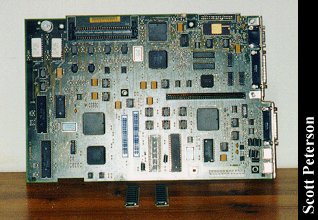|
Most of the information on this page comes from Scott Peterson's page
(original HERE).
Edited by Major Tom.
The IBM Personal Typing System is an application specific workstation
integrating the functions of a word processor and typewriter. It includes a
system unit, system and application software, keyboard, color or monochrome
display, and an impact or non impact printer. It can also be used as a personal
computer capable of running PC applications under DOS 3.3. With the addition of
an optional expansion unit, it will accomodate up to three full size personal
computer adapter cards for additional applications, such as communications in a
host environment.

IBM Personal Typing System - Type 6900
IBM Personal Typing System, circa 1987. I like this computer; like the Dodge
Neon it can't do much but it has a nice personality. Here it is shown with
expansion box and a contemporary IBM ProPrinter II. It's an 8086 with 640K of
RAM, a 20 Meg hard drive, monochrome CGA graphics, and a 720K floppy drive.
It's interesting to note the monitor (original) is a monochrome VGA, which the
card is capable of driving.
I can only think the reason this computer was made was because someone at
IBM refused to let the concept of the Displaywriter die. It's a PS/2 series Model 30-8086 (there was also a Model
30-286 made to make it more confusing) motherboard turned sideways and fit into
a smaller case. While most PS/2's used the Micro Channel (MCA) bus, the Model
30-8086 used a standard ISA bus. However, on the Personal Typing System the bus
socket communicates via a ribbon cable to an empty socket on the bottom of the
case. In order to hook up any ISA cards it was necessary to buy the expansion
box that had the ISA bus and sockets and its own power supply, which fit
underneath the main case. Everything hooks up on the right side of the upper
case, accessible via a metal door. While it made a compact computer, this also
seemed an incredibly wasteful arrangement.
As it came this one had IBM PC-DOS 3.30 and WordPerfect 5.1 on it, in
addition to a few other programs. I guess because I like to do things the hard
way I decided to install DOS 6.22 on it, never mind that DOS 6.22 comes on 1.44
meg floppies and this only has a 720K drive. I got around it by making a 720K
boot disk for DOS 6.22, booting the machine with it and writing the system
files onto the hard drive. Then I copied using 720K floppies all the DOS files
from another installation, and viola! DOS the hard way! I like this machine
enough that I use it for secondary typing tasks and am considering installing a
modem to use it as an e-mail reader.

View of open upper case
This computer uses either an ESDI or semi-IDE IBM hard drive, at least one
reason why it runs faster than most other 8086's I've used. Behind the metal
plate on the left can be seen the 256K RAM chips, which are very unusual
looking. The green and white wires are where I jumped around a break in the
ribbon cable for the timer battery, the only real problem I've had with this
machine.

View of case showing how it's really two cases connected together

View of lower case, showing ISA bus and separate power supply

The motherboard, a standard Model 30-8086 board
|